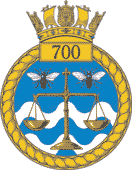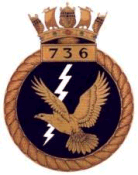| No. 700 Naval Air Squadron (700NAS)
It reformed seven months later in October, at RNAS Donibristle, as a Maintenance Test Pilot Training Squadron, where pilots were required to complete 5 weeks test flying on the basic FAA aircraft then in service. This course ran for ten weeks at Worthy Down airfield after the Squadron’s move, and included experience in the Martlet, Firefly, Hellcat, Firebrand and Seafire amongst others. 700NAS was later based at Middle Wallop from November 1945, and RNAS Yeovilton from April 1946, and remained based there until disbandment in September 1949. It reformed for a third time in August 1955, at RNAS Ford as the Trials and Requirements Unit, with a fleet of 9 Firefly TT.4s, and 2 each of Sea Vampire F.20s, Ansons, Sea Hawks, Wyverns and Gannets. It lost its Fleet Requirements role when handed over to the Airwork FRU at Hurn during 1957. A year later the Squadron moved to Yeovilton, before disbanding in 1961. It’s Hunter service was brief, being on three separate occasions. A single T.8 XL582, shortly after delivery from Hawkers was employed by 700Y NAS, the Sea Vixen FAW.1 trials unit. The aircraft was in use between November 1958 and January 1959, and the Unit disbanded six months later in July. At least two Hunter T.8s, XF358 and WW664, were attached to 700Z NAS at RNAS Lossiemouth between May 1961 and September 1962 when the Admiralty received the first examples of the Blackburn Buccaneer S.1. The Unit disbanded in January 1963 when the trials were completed. It is also reported that at least one other Hunter, T.8 WV319 also served with the Squadron but this is unconfirmed at the time of writing. 700 NAS’ last era of Hunter operations lasted just two months. T.8 XE664 was used by 700B NAS, based at RNAS Lossiemouth, between April and May 1965 at a time when the Blackburn Buccaneer Mk.2s were arriving on strength. 700B disbanded in September 1965. No. 736 Naval Air Squadron (736NAS) Unfortunately no images are available to download as yet. Can you help with further photos? If so please get in touch. Full credit will of course be given No. 736 Naval Air Squadron (700NAS)
Just a day later, 736NAS reformed at RNAS Culdrose as an Advanced Jet Flying School, and received Supermarine Attackers and Meteor T.7s. It moved to RNAS Lossiemouth in November 1953 where the entire fleet was exchanged for Sea Vampires and Sea Hawks. A change of role occurred in 1955, when the unit became responsible for training all FAA pilots who had been trained in the USA to British standards and aircraft. The Sea Hawks departed as a result, but they returned in 1958 when 736NAS became a Sea Hawk training Unit. Re-equipping with Scimitars from May 1959, the Squadron remained in commission until 26th March 1965 when it was disbanded, and the aircraft passed onto 764B NAS. 736nas reformed the same day at RNAS Lossiemouth as a Buccaneer S.1 unit. These aircraft were partially replaced by Buccaneer S.2s from May 1966, and the Squadron was disbanded in February 1972. In June 2013. 736NAS was reformed at RNAS Culdrose with 14 BAe Hawk platforms following the withdrawal and standing down of the Fleet Requirements and Air Direction Unit (FRADU). |
 700 NAS was first formed at Hatston on 21st January 1940, by amalgamating all the 700 series of Catapult Squadrons. It’s initial fleet comprised over 40 Supermarine Walrus’, 12 Swordfish and 11 Seafoxes.
700 NAS was first formed at Hatston on 21st January 1940, by amalgamating all the 700 series of Catapult Squadrons. It’s initial fleet comprised over 40 Supermarine Walrus’, 12 Swordfish and 11 Seafoxes. 736 NAS was first formed at RNAS Yeovilton on 24th May 1943 as the School of Air Combat, and was equipped with Seafire Mk.1Bs. It’s purpose was to teach the latest air combat techniques to experienced naval aviators. The Unit moved to St Merryn in Cornwall during September 1943, where Miles Masters and Fairey Barracudas were added to the Squadron’s inventory. Between 1943 and 1950 the Squadron operated numerous types, including Supermarine Seafires, Hawker Sea Furies and Fairey Fireflies.
736 NAS was first formed at RNAS Yeovilton on 24th May 1943 as the School of Air Combat, and was equipped with Seafire Mk.1Bs. It’s purpose was to teach the latest air combat techniques to experienced naval aviators. The Unit moved to St Merryn in Cornwall during September 1943, where Miles Masters and Fairey Barracudas were added to the Squadron’s inventory. Between 1943 and 1950 the Squadron operated numerous types, including Supermarine Seafires, Hawker Sea Furies and Fairey Fireflies.